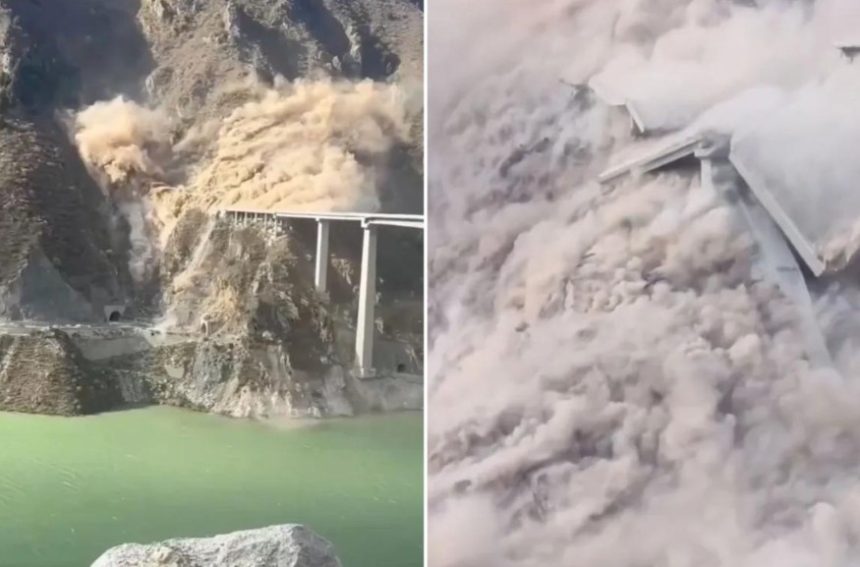A brand-new ground in China’s Sichuan Province has collapsed just days after its grand opening, sparking wide outrage, disbelief, and a fresh surge of reviews over the country’s construction norms.
The China ground collapse, involving the recently opened Hongqi Bridge, has once again drawn attention to the growing concerns about structural safety in China.
Authorities have verified that there were no casualties, as the ground had been closed to business shortly before the incident due to visible cracks in the girding area.
Still, footage showing a large section of the 758-meter ground breaking piecemeal and plunging into the swash below has swamped social media, leaving numerous shocked and questioning how such a disaster could be so soon after completion.
Viral Outrage and “Made in China” Debate
Videos of the Hongqi Bridge collapse quickly went viral on Chinese and international platforms, with the phrase “Made in China” trending once again, this time not as a mark of pride but as a sarcastic criticism.
Many social media users mocked the event as yet another example of poor oversight in China’s fast-paced development drive. One user wrote, “A bridge that can’t last a week, what does that say about our construction quality?”
The Hongqi Bridge in Shuangjiangkou, Sichuan Province, China, partially collapsed today. Authorities believe that cracks in the nearby mountainside — likely caused by water accumulation from a nearby reservoir — played a major role in the incident. pic.twitter.com/v1bdbj5KLJ
— Weather Monitor (@WeatherMonitors) November 11, 2025
The ground, erected by the state- possessed Sichuan Road and Bridge Group, was meant to be a major link between central China and the Tibetan Plateau, serving both original communities and indigenous trade routes.
Rather, its collapse has come to be emblematic of deeper issues girding Chinese construction quality and engineering norms.
Warning Signs Before the Collapse
Local officials in Maerkang reported early signs of trouble before the Sichuan landslide occurred. Cracks had started forming along the near pitches and highways, urging authorities to close the ground as a precaution.
That quick decision likely saved lives. Still, the following day, the unstable mountain pitch gave way fully, driving a massive landslide that destroyed part of the road and tore through the ground’s support structure.
Primary examinations suggest that while the ground itself was erected according to sanctioned regulations, the geological conditions in the area were far too unstable.
Experts say that landslide-prone regions like Maerkang bear fresh underpinning and monitoring, which might not have been adequately enforced in this case.
Government Promises Full Investigation
Chinese authorities have since launched a comprehensive, specialized investigation into the Hongqi Bridge disaster.
Masterminds and safety experts are now examining whether structural design excrescencies, construction crimes, or natural geological insecurity were the main causes of the collapse.
Government officers have pledged transparency, though rebuilding public trust may prove delicate. The event has reignited debates over whether China’s rapid-fire structure expansion, frequently completed in record time, may be compromising long-term safety norms.
Global Scrutiny on China’s Construction Boom
The Hongqi Bridge collapse has made headlines around the world, fuelling scepticism over the sustainability of China’s structure smash.
Over the once two decades, the country has constructed thousands of kilometres of roadways, coverts, and islands at a snappy speed.
While numerous systems have showcased emotional engineering feats, others have raised concerns about conservation, material quality, and oversight.
Experts note that China’s terrain, marked by mountainous regions and seismic activity, poses fresh challenges. Without proper geotechnical assessments, indeed, well-erected structures can face pitfalls in areas prone to landslides or corrosion.
A Wake-Up Call for Infrastructure Accountability
For many, the Hongqi Bridge incident is a sobering reminder that speed should in no way come before safety. As China continues its drive for modernisation, the collapse serves as a call for stricter structural norms, better geological monitoring, and transparent examinations into public workshop systems.
The world will be watching as China’s masterminds and officers work to uncover the truth behind the ground collapse in Sichuan, hoping that lessons learned will help prevent future tragedies on such a scale.






